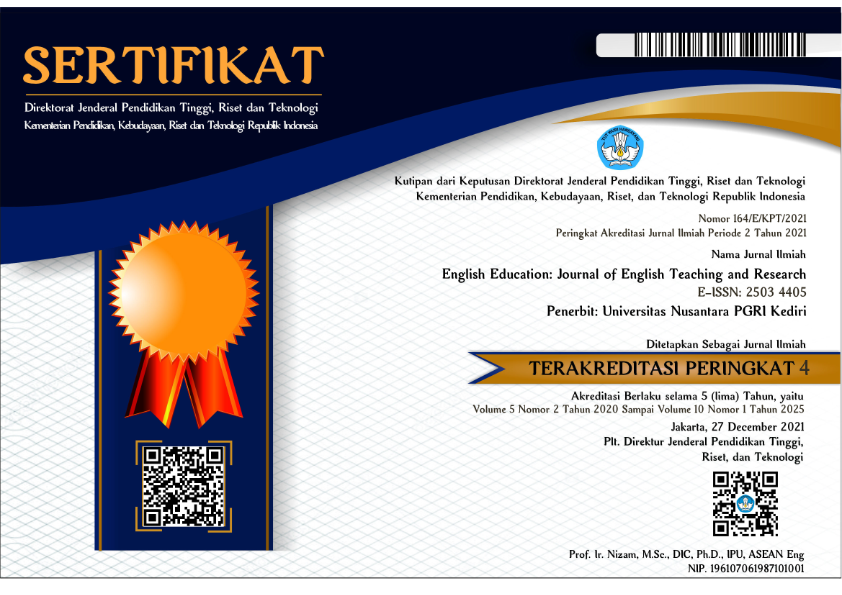The Use of Code-Crossing in EFL Classroom Interaction
DOI:
https://doi.org/10.29407/jetar.v10i2.26444Keywords:
classrom interaction; code-crossing; EFL classroom , EFL classroom , code-crossing, classrom interactionAbstract
The purposes of this research were to find out the forms and factors that cause code-crossing in EFL classroom interaction. This research was conducted using a descriptive qualitative approach. The researchers selected thirty participants from the English Education Department at Universitas Muhammadiyah Sorong (Muhammadiyah University of Sorong). The researchers took participants from the fourth semester. The researchers observed the activity in the class during the teaching process. The data of this study were collected by using classroom observation and interview. The researchers used five stages in analyzing the data, which are data cleaning, data coding, descriptive analysis, comparative analysis, and interpretation of results. The research revealed that the way lecturers and students engage in code-crossing, using both high and low codes, is shaped by social status, social distance, and mutual familiarity. Findings indicated that classroom interactions involved two main types of codes: high and low codes. Students predominantly employed high code, whereas lecturers were more inclined to use low code. Key determinants for code selection included the lecturer’s social status and age differences. Additionally, factors such as social distance, familiarity, and cultural background also played role in influencing the use of high code by both lecturers and students during classroom exchanges. These findings suggest that language within educational contexts serves purposes beyond mere communication. It reflects cultural norms, social expectations, and interpersonal relationships. Understanding how lecturers and students engage in code-crossing offers valuable insights into enhancing classroom interaction, inclusivity, and mutual respect. The key contribution of this research lies in its empirical evidence showing that code-crossing, often perceived as informal or peripheral, actually plays a crucial role in shaping effective classroom communication and fostering social cohesion.
Downloads
References
Creswell, J. W. (2012). Educational Research: Planning, Conducting, and Evaluating Quantitative and Qualitative Research (4th Edition). New Jersey: Pearson. Notes and Queries, s4-I(25), 577. https://doi.org/10.1093/nq/s4-I.25.577-c
Dovchin, S. (2019). Language crossing and linguistic racism: Mongolian immigrant women in Australia. Journal of Multicultural Discourses, 14(4), 334-351. https://doi.org/10.1080/17447143.2019.1566345
Ferguson, G. (2003). Classroom code-switching in post-colonial contexts: Functions, attitudes and policies. AILA review, 16(1), 38-51. https://doi.org/10.1075/aila.16.05fer
Fitriani, N., Rofiq, A., & Ariani, M. (2025). English Teachers’ Innovative Approach to Teaching Speaking Skills. English Education: Journal of English Teaching and Research, 10(1), 92-100. https://doi.org/10.29407/jetar.v10i2.24216
Nisa, Hoerun S. (2014). Classroom Interaction Analysis in Indonesian EFL Speaking Class. English Review: Journal of English Education, 2(2), 1–9. https://doi.org/10.25134/erjee.v2i2.99
Kamwangamalu, N. M. (2008). Code-switching, code-crossing and identity construction in a society in transition, South Africa. In Us and Others (pp. 187-210). John Benjamins Publishing Company. Retrived from https://www.degruyterbrill.com/document/doi/10.1075/pbns.98.11kam/html
Moats, L. C., & Brady, S. (2020). Speech to print: Language essentials for teachers (p. 304). Paul H. Brookes Publishing Company. Retrived from https://www.saint-gobain.co.in/sites/saint teachers-second-edition-louisa-moats-phd-pdf-download-free-book-9bf3ac6.pdf
Pooley, T., & Mostefai-Hampshire, Z. (2012). Code-crossing and multilingualism among adolescents in Lille. Journal of French Language Studies, 22(3), 371-394. https://doi.org/10.1017/S0959269512000208
Purwati, D. (2019). Formal and Informal Talks of Lecturers in EFL Classroom Interaction (Doctoral dissertation, Universitas Negeri Makassar). Retrived from https://eprints.unm.ac.id/13375/1/ARTIKEL.pdf
Rampton. (2020). An Introduction to Sociolinguistics, Code-Crossing. In An Introduction to Sociolinguistics, Sixth Edition. https://doi.org/10.4324/9780367821852
Simpuruh, I., Mahmud, M., Salija, K., & Halim, A. (2020b). Code-crossing in indonesian EFL classroom interaction. International Journal of Language Education, 4(3), 334–349. https://doi.org/10.26858/ijole.v4i3.13969
Simpuruh, K., & Halim, A. M. (2023). Code-Crossing in Indonesian EFL Classroom Interaction: A Study of Language Mixing and Switching Patterns. American Journal of Philological Sciences, 3(06), 1-5. https://doi.org/10.37547/ajps/Volume03Issue06-01
Stockwell, P. (2002). Sociolinguistics: A resource book for students. London and New Yotk. Psychology Press. Retrived from https://books.google.co.id/books?id
Wajdi, M., Laksana, I. K. D., Suastra, I. M., & Budiarsa, M. (2010). Code-crossing: Hierarchical Politeness in Javanese. In Proceeding of International Seminar on Austronesian Languages, held by PPs S (Vol. 2). Retrived from https://www.researchgate.net/publication/326357622_E-Journal_CODE-CROSSING_HIERARCHICAL_POLITENESS_IN_JAVANESE
Wael, A., Noor, L., Saputra, D., & Hartanti, R. (2025). Papuan EFL Learners’strategies in Acquiring English. Linguists: Journal of Linguistics and Language Teaching, 11(1), 46-56. http://dx.doi.org/10.29300/ling.v11i1.5188
Wardhaugh. (2010). An introduction to linguistics. Hoboken USA. Basil Blackwell Ltd Publishing. Retrived from https://books.google.co.id/books?id
Downloads
Published
Issue
Section
License
Copyright (c) 2025 Ahmad Wael, Yuliana A.,, Rezkiah Hartanti, Ana Fadila

This work is licensed under a Creative Commons Attribution-ShareAlike 4.0 International License.
Authors who publish with this journal agree to the following terms:
- Copyright on any article is retained by the author(s).
- The author grants the journal, the right of first publication with the work simultaneously licensed under a Creative Commons Attribution License that allows others to share the work with an acknowledgment of the work’s authorship and initial publication in this journal.
- Authors are able to enter into separate, additional contractual arrangements for the non-exclusive distribution of the journal’s published version of the work (e.g., post it to an institutional repository or publish it in a book), with an acknowledgment of its initial publication in this journal.
- Authors are permitted and encouraged to post their work online (e.g., in institutional repositories or on their website) prior to and during the submission process, as it can lead to productive exchanges, as well as earlier and greater citation of published work.
- The article and any associated published material is distributed under the Creative Commons Attribution-ShareAlike 4.0 International License








 Article template
Article template



